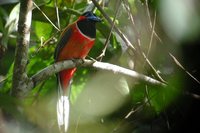|
| Query: bird | Result: 9607th of 32675 | |
Red-naped Trogon - Harpactes kasumba

| Resolution: 676x449
File Size: 64795 Bytes
Date: 2004:04:02 21:17:26
Camera: E990 (NIKON)
F number: f/2.6
Exposure: 10/574 sec
Focal Length: 99/10
Upload Date: 2008:07:16 11:42:06
|
|
|

